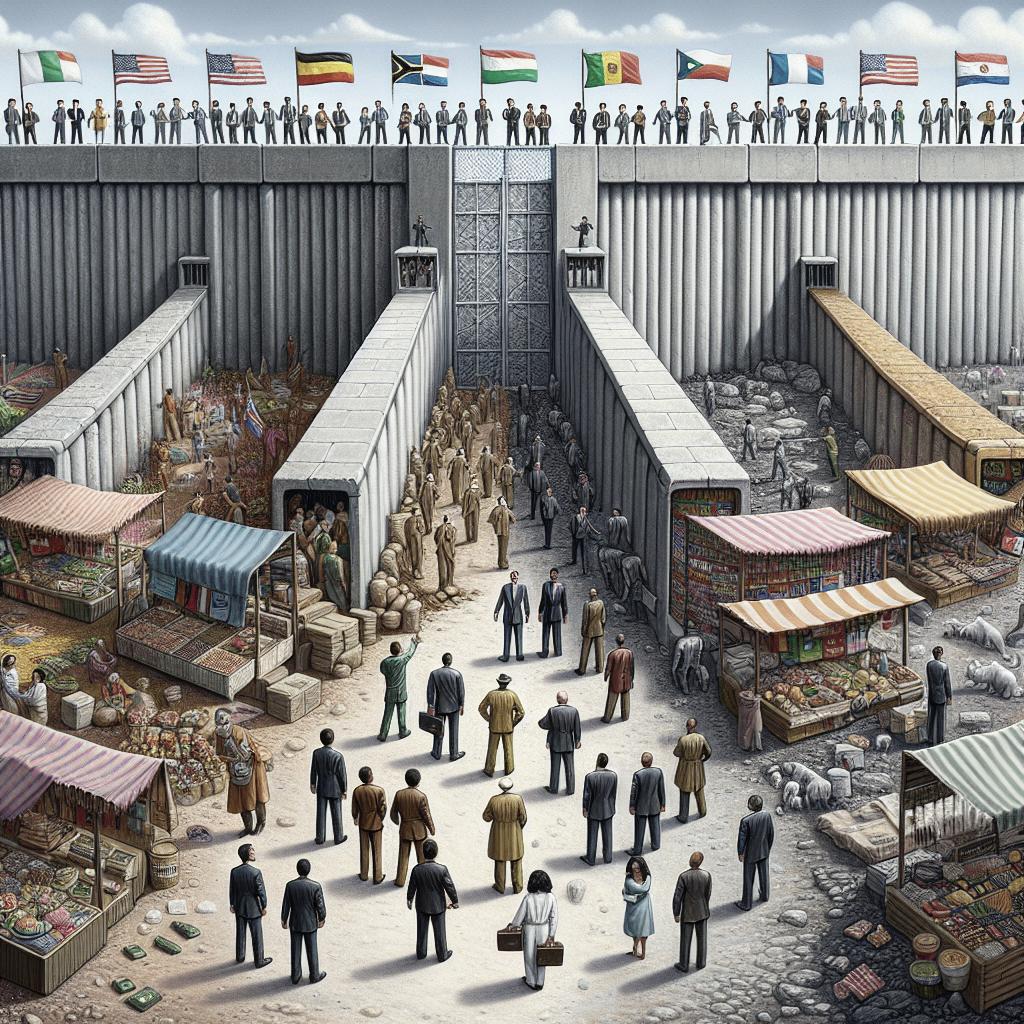Understanding Trade Barriers and Their Consequences
Trade barriers, including tariffs and non-tariff measures, are essential components of international trade policy. While they are often implemented to protect domestic industries and maintain national security, their broader economic implications can be profound. This blog post will explore what tariffs are, their various types, the reasons behind their implementation, and their consequences. We’ll delve into who benefits from tariffs, how they affect prices, and their role in modern trade. By examining these aspects, readers will gain a comprehensive understanding of the balance that trade barriers represent between protectionism and free trade.
What Are Tariffs?
Tariffs are taxes imposed by a government on imported goods and services. These taxes increase the cost of imported items, making them more expensive compared to domestic products. The primary objective of tariffs is to restrict imports by raising the price of goods and services purchased from overseas, thereby encouraging consumers to buy domestic products.
There are various forms of tariffs, including specific and ad valorem tariffs, which vary in their application and objectives. Specific tariffs are levied as a fixed fee based on the type of item being imported, such as a dollar amount on each item. On the other hand, ad valorem tariffs are levied as a percentage of the item’s total value, thus adjusting the tax based on price fluctuations.
Key Takeaways
- Tariffs are government-imposed taxes on imported goods and services, designed to encourage domestic consumption.
- Two primary forms of tariffs include specific tariffs and ad valorem tariffs, each with distinct characteristics.
- The overarching goal of tariffs is to create a barrier to imports, aiding domestic industries by making foreign goods more costly.
Who Collects a Tariff?
The collection of tariffs is generally handled by the relevant customs authorities in a country’s government. Typically, the importer pays the tariff when the goods cross the border. The revenue generated from tariffs is a significant source of income for many governments, funding public infrastructure, services, and other economic activities.
The process of collecting tariffs involves strict documentation and compliance with international trade regulations. Ensuring that tariffs are accurately assessed and collected is crucial, as any discrepancies can lead to legal issues or trade disputes between nations.
Why Are Tariffs and Trade Barriers Used?
Protecting Domestic Employment
One of the primary reasons for implementing tariffs is to protect domestic employment. By making imported goods more expensive, tariffs encourage consumers to buy domestically produced goods, thereby supporting local industries and preserving jobs. This protection can be crucial in sectors facing tough competition from cheaper, foreign products.
However, while tariffs safeguard existing jobs, they can also lead to inefficiencies in domestic industries that might otherwise need to innovate to remain competitive. In some instances, this protectionism can result in higher prices for consumers and limited choices.
Protecting Consumers
Tariffs are also employed to protect consumers from potentially harmful foreign products that do not meet the importing country’s safety standards. By imposing high tariffs on such goods, governments can reduce their import, thereby safeguarding the consumer market.
This aspect of protection can sometimes extend to products that could threaten public health, such as certain pharmaceuticals or food products. However, the protective nature of tariffs can be a double-edged sword, as it may also limit consumer access to high-quality international products.
Infant Industries
Tariffs can serve as a nurturing environment for ‘infant industries’ – new sectors or businesses that require time to develop before facing international competition. By applying tariffs, governments afford these nascent industries a competitive edge at home, allowing them to grow and become more competitive globally.
Despite their potential benefits, tariffs for infant industries must be applied judiciously. If protracted, these protections can deter industry evolution and innovation, ultimately disadvantaging the very industries they intended to support.
National Security
Another reason for imposing tariffs and trade barriers is the protection of national security. Governments might restrict imports of certain goods considered vital for national defense, such as technology related to military applications, to reduce dependence on foreign sources.
While this strategy can be effective in sustaining national security, overemphasis on protectionism can strain international relations and prompt retaliatory measures, affecting global trade dynamics.
Retaliation
Tariffs can also be used as instruments of retaliation in trade disputes. When a country believes that it has been unfairly targeted by another’s trade practices, it may impose tariffs to pressure the offending nation into changing its policies.
Although effective in signaling dissatisfaction, retaliatory tariffs can escalate tensions and trigger trade wars, harming global trade and economic growth.
Common Types of Tariffs
Specific Tariffs
Specific tariffs are straightforward; they assign a fixed fee on imported goods based on their type and quantity. For example, a country might impose a $1 tariff on each pair of shoes. This method provides certainty regarding the amount of duty levied per item, simplifying calculations for businesses engaged in trade.
However, specific tariffs do not adjust according to changes in the value of the goods, which can lead to discrepancies in effective tariff levels across varying price ranges of products.
Ad Valorem Tariffs
Ad valorem tariffs are computed as a percentage of the value of the imported goods. For instance, a 10% tariff on cars would mean an additional charge of 10% on the car’s total cost upon reaching the border.
This type of tariff is beneficial for adjusting with fluctuating values of products, maintaining a consistent level of protection regardless of how the market price of goods changes. However, they require precise valuation of goods, which can complicate tariff collection efforts.
Non-Tariff Barriers to Trade
Licenses
Licenses serve as a non-tariff barrier, imposing stringent regulations on the importation of certain goods. These licenses ensure that only authorized and compliant goods are allowed into the market, restricting the free flow of trade.
While licensing can guarantee that imports meet specific standards, the process of obtaining licenses may become bureaucratically cumbersome, potentially delaying shipments and increasing operational costs for traders.
Import Quotas
Import quotas set a physical limit on the quantity of certain goods that can be imported during a specific period. They are used to prevent market saturation from foreign products, protecting domestic industries from extreme competition.
Quotas can artificially inflate prices by limiting supply, leading to higher costs for consumers while trying to secure sufficient domestic market share for local producers.
Voluntary Export Restraints (VER)
VERs involve an exporting country voluntarily limiting the quantity of goods it exports to a particular country. These restraints are often the result of negotiations between governments aiming to prevent more severe trade barriers being imposed.
Despite being labelled ‘voluntary’, VERs stem from diplomatic pressures that can distort market dynamics and impact trade relations.
Local Content Requirement
Local content requirements mandate that a certain percentage of a final product must come from local sources. This requirement encourages foreign companies to use domestic goods or services, boosting local industry.
While incentivizing local production can benefit domestic businesses, strict local content mandates might discourage foreign investment, as firms may find it challenging or costly to meet these requirements.
Who Benefits From Tariffs?
Primarily, local industries and workers benefit from tariffs as they enjoy reduced competition from foreign firms. This protection allows industries the space to grow, innovate, and solidify their market presence domestically.
Governments also benefit from tariffs through increased revenues and exercises of regulatory control over international trade. However, these beneficiaries are counterbalanced by consumers who may suffer from higher prices and fewer product choices.
How Do Tariffs Affect Prices?
Tariffs typically raise the prices of imported goods, making them less favorable compared to domestic alternatives. By artificially increasing costs, tariffs distort market prices, which can lead to decreased demand for foreign goods and an eventual shift towards more expensive domestic products.
This shift might benefit local producers, but it often results in a significant financial burden on consumers who endure higher prices, reduced variety, and potentially lower-quality goods.
Tariffs and Modern Trade
In today’s interconnected global economy, tariffs are pivotal tools that nations use to navigate international trade landscapes. With the advent of free trade agreements and global alliances, tariffs provide a mechanism for countries to negotiate terms and assure equitable trade practices.
Modern trade increasingly involves complex global supply chains, where products are assembled across multiple countries. In such contexts, tariffs can disrupt these intricate networks, leading to inefficiencies and increased costs.
What Are the Main Types of Trade Barriers?
Trade barriers can be broadly categorized into tariffs and non-tariff measures. Tariffs impose financial charges on imported goods, whereas non-tariff barriers include mechanisms like quotas, embargoes, and regulations that restrict trade.
By examining both categories, one can discern how trade barriers serve diverse strategic objectives, whether economic, political, or social. Understanding these categories is vital for businesses and policymakers navigating international trade.
What Is an Example of a Tariff?
A prominent example of a tariff is the US-China trade war, where the United States imposed tariffs on billions of dollars’ worth of Chinese goods. These tariffs targeted various sectors, including technology and manufacturing, with the goal of addressing trade imbalances and intellectual property concerns.
This trade conflict illustrated the complexities of tariff imposition, revealing both the strategic intent and the economic repercussions of such measures on global trade patterns.
Do Tariffs Cause Inflation?
Tariffs can contribute to inflation by raising the prices of imported goods, which in turn affects the overall consumer price index. As import costs rise due to tariffs, domestic sellers may likewise increase their prices, further enhancing inflationary pressures.
While the direct effect varies depending on the extent and scope of the tariffs, sustained tariffs can permeate through the economy, leading to broader inflation across various sectors.
Summary of Main Points
| Aspect | Details |
|---|---|
| Tariffs | Taxes on imports aimed at protecting domestic industries. |
| Why Tariffs are Used | Protect employment, consumers, infant industries, national security, and for retaliation. |
| Types of Tariffs | Specific tariffs and ad valorem tariffs. |
| Non-Tariff Barriers | Include licenses, quotas, VERs, and local content requirements. |
| Benefits | Mainly local industries, but consumers may face higher prices. |
| Modern Trade | Involves complex global supply chains affected by tariffs. |
| Inflation | Tariffs can lead to broader economic inflation. |


